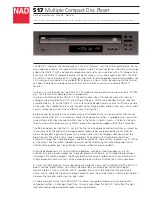
10
3.8 Random play
Press
PROG (4) and after that PAUSE (11).
Now a random playlist will be generated.
Deleting a random playlist:
Press
PROG (4) and after that STOP (10).
and the playlist is deleted.
3.9 Select input (CD8, CD8T only)
The CD8 / CD8T have seven digital inputs. They can be selected using the < and > buttons (2, 3). NOTE:
This works only while the FILTER function (see 3.10) is NOT active.
While one of the digital inputs is selected, it's signal is played. If there is no valid signal the display (8) will
show "NO SIGNAL".
You can easily come back to CD mode by pressing PLAY (12).
3.10 Select filter (CD8, CD8T only)
Press the button FILTER (5) to activate filter setting. Select filter using the buttons < or >
(2, 3). The display
(8) shows the actual setting in the lower line.
The different filters are:
192 kHz / 24 Bit / smooth,
192 kHz / 24 Bit / sharp,
176,4 kHz / 24 Bit / smooth,
176,4 kHz / 24 Bit / sharp,
96 kHz / 24 Bit / smooth,
96 kHz / 24 Bit / sharp,
88,2 kHz / 24 Bit / smooth,
88,2 kHz / 24 Bit / sharp,
48 kHz / 24 Bit / smooth,
48 kHz / 24 Bit / sharp,
44,1 kHz / 24 Bit / smooth,
44,1 kHz / 24 Bit / sharp.
"sharp" means a flat amplitude and a sharp filter slope at the end of the passband with noticeable phase
deviation.
"slow" means a slight amplitude error at the end of the passband but low phase deviation.
Remark:
For upsampling frequencies high above the incoming sampling frequency (CD: 44.1 kHz) phase
and amplitude errors have nearly no audible effects because the filtering is in a region where no audio signal
is present.
The filter setting is according to your personal taste. The tonal results can vary depending on the recording
mode of the CD or the incoming digital signal.
The filter setting is assigned to the actual input and will be stored. That means, you can chooses different
characteristices for each input and the CD.
To deactivate filter setting press FILTER (5) again.
































